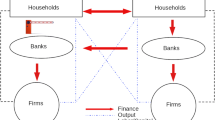Abstract
During the past thirty years, central banks often intervened in foreign exchange markets. Sometimes they carried out foreign exchange market interventions on a unilateral basis. However, central banks often coordinated their foreign exchange market interventions. We develop a quantitative reaction function model that renders it possible to study the factors that made central banks switch from unilateral to coordinated interventions. We apply our model to the intervention policies of the Japanese monetary authorities and the U.S. Federal Reserve in the yen/U.S. dollar market during the period 1991–2001. To this end, we use recently released official data on the foreign exchange market interventions of the Japanese monetary authorities. JEL no. F31, F33, G14, G15
Similar content being viewed by others
References
Aguilar, J., and S. Nydahl (2000). Central Bank Intervention and Exchange Rates: The Case of Sweden.Journal of International Financial Markets, Institutions and Money 10(3/4): 303–322.
Aitchison, J., and S. D. Silvey (1957). The Generalization of the Probit Analysis to the Case of Multiple Responses.Biometrika 44 (1/2): 131–140.
Almekinders, G. J. (1995).Foreign Exchange Intervention: Theory and Evidence. Aldershot: Elgar.
Almekinders, G. J., and S. C. W. Eijffinger (1994). Daily Bundesbank and Federal Reserve Interventions.Empirical Economics 19 (1): 111–130.
Almekinders, G. J., and S. C. W. Eijffinger (1996). A Friction Model of Daily Bundesbank and Federal Reserve Intervention.Journal of Banking and Finance 20 (8): 1365–1380.
Baillie, R. T., and W. P. Osterberg (1997a). Why Do Central Banks Intervene?Journal of International Money and Finance 16 (6): 909–919.
Baillie, R. T., and W. Osterberg (1997b). Central Bank Intervention and Risk in the Forward Market.Journal of International Economics 43 (3–4): 483–497.
Beine, M., A. Bénassy-Quéré, and C. Lecourt (2002). Central Bank Intervention and Foreign Exchange Rates: New Evidence from FIGARCH Estimations.Journal of International Money and Finance 21 (1): 115–144.
Bonser-Neal, C., and G. Tanner (1996). Central Bank Intervention and the Volatility of Foreign Exchange Rates: Evidence from the Options Market.Journal of International Money and Finance 15 (6): 853–878.
Campbell, J. Y., A. W. Lo, and A. C. MacKinley (1997).The Econometrics of Financial Markets. Princeton, N.J.: Princeton University Press.
Davutyan, N., and W. R. Parke (1995). The Operations of the Bank of England, 1890–1908: A Dynamic Probit Approach.Journal of Money, Credit, and Banking 27 (4): 1099–1112.
DeGroot, M. H. (1989).Probability and Statistics. Reading, Mass.: Addison-Wesley.
Dominguez, K. M. (1998). Central Bank Intervention and Exchange Rate Volatility.Journal of International Money and Finance 17 (1): 161–190.
Dominguez, K. M., and J. A. Frankel (1993). Does Foreign Exchange Intervention Matter? The Portfolio Effect.American Economic Review 83 (5): 1356–1369.
Edison, J. J. (1993).The Effectiveness of Central Bank Interventions: A Survey of the Post-1982 Literature. Special Papers in International Economics 18. Princeton, N.J.: Princeton University Printing Service.
Eichengreen, B., M. W. Watson, and R. S. Grossman (1985). Bank Rate Policy under the Interwar Gold Standard: A Dynamic Probit Model.Economic Journal 95 (September): 725–745.
Fase, M. M. G., and A. P. Huijser (1994). Foreign Exchange Rate Stabilization and the Profitability of Official Market Intervention: A Case Study for the Netherlands 1974–1989.Kredit und Kapital 27 (2): 212–234.
Federal Reserve Bank of New York (2002).Foreign Exchange Treasury and Federal Reserve: FX Operations. http://www.ny.frb.org/pihome/news/forex
Fischer, A., and M. Zurlinden (1999). Exchange Rate Effects of Central Bank Interventions: An Analysis of Transaction Prices.Economic Journal 109 (October): 662–676.
Greene, W. H. (2000).Econometric Analysis. London: Prentice Hall.
Humpage, O. F. (1994). Institutional Aspects of U.S. Intervention.Federal Reserve Bank of Cleveland Economic Review 30 (2): 2–19.
Ito, T. (2002).Is Foreign Exchange Intervention Effective? — The Japanese Experiences in the 1990s. Working Paper 8914. National Bureau of Economic Research, Cambridge, Mass.
Japanese Ministry of Finance (2002).Foreign Exchange Operations. http://www.mof.go.jp/english/elc021.htm
Kim, S. J., and J. Sheen (2002). The Determinants of Foreign Exchange Intervention by Central Banks: Evidence from Australia.Journal of International Money and Finance 21 (5): 619–649.
Kim, S. J., T. Kortian, and J. Sheen (2000). Central Bank Intervention and Exchange Rate Volatility — Australian Evidence.Journal of International Financial Markets, Institutions, and Money 10 (3/4): 381–405.
Leahy, M. P. (1995). The Profitability of US Intervention in the Foreign Exchange.Journal of International Money and Finance 14 (6): 823–844.
LeBaron, B. (1999). Technical Trading Rule Profitability and Foreign Exchange Intervention.Journal of International Economics 49 (1): 125–143.
Neely, C. J. (1998). Technical Analysis and the Profitability of U.S. Foreign Exchange Intervention.Federal Reserve Bank of St. Louis Review 80 (4): 3–17. http://www.stls.frb.org/publications/review/indexbak.html
Neely, C. J. (2002). The Temporal Pattern of Trading Rule Returns and Exchange Rate Intervention: Intervention Does Not Generate Technical Trading Profits.Journal of International Economics 58 (1): 211–232.
Saacke, P. (2002). Technical Analysis and the Effectiveness of Central Bank Intervention.Journal of International Money and Finance 21 (4): 459–479.
Schwartz, A. J. (2000). The Rise and Fall of Foreign Exchange Market Intervention as a Policy Tool.Journal of Financial Services Research 18 (2/3): 319–339.
Sjoo, B., and R. J. Sweeney (2000). Time-Varying Foreign-Exchange Risk and Central Bank Intervention: Estimating Profits from Intervention and Speculation.Journal of International Financial Markets, Institutions, and Money 10 (3/4): 275–286.
Sjoo, B., and R. Sweeney (2001). The Foreign Exchange-Costs of Central Bank Intervention: Evidence from Sweden.Journal of International Money and Finance 20 (2): 219–247.
Szakmary, A. C., and I. Mathur (1997). Central Bank Intervention and Trading Rule Profits in Foreign Exchange Markets.Journal of International Money and Finance 16 (4): 513–535.
Author information
Authors and Affiliations
Corresponding author
About this article
Cite this article
Frenkel, M., Pierdzioch, C. & Stadtmann, G. Modeling coordinated foreign exchange market interventions: The case of the Japanese and U.S. interventions in the 1990s. Review of World Economics 139, 709–729 (2003). https://doi.org/10.1007/BF02653110
Issue Date:
DOI: https://doi.org/10.1007/BF02653110




